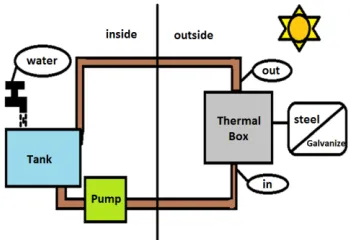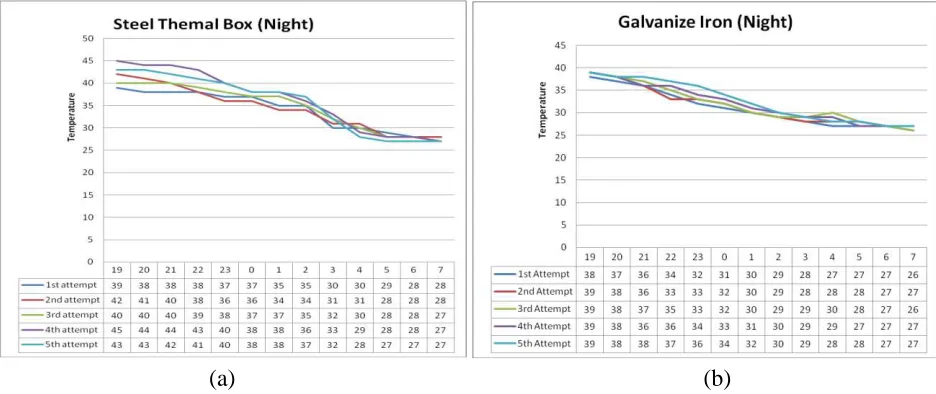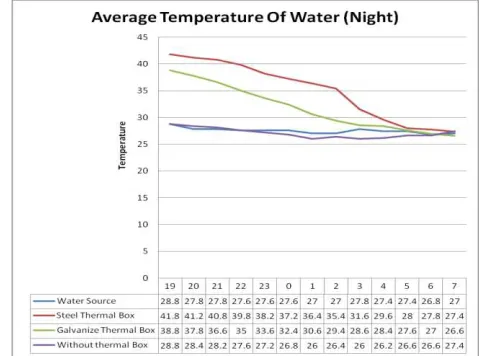An Experimental Study of Different Thermal Boxes Heated by Solar
Department of Manufacturing Process, Faculty of Manufacturing Engineering, Universiti Teknikal Malaysia Melaka, Hang Tuah Jaya, 76100, Durian Tunggal, Melaka, Malaysia.
a
[email protected], [email protected], [email protected], c
[email protected], [email protected], [email protected]
Keywords: Thermal Efficiency; Water Heating; Thermal Boxes; Solar Night.
Abstract.This research is related to thermal efficient water heating system, specifically to improve the water heating system that exists nowadays. The goal of this research is to improve the current water heating system by using solar heat as the energy source to heat the water. The focus is to improve the thermal efficiency by adding different thermal boxes as the absorber bed. By implementing the black body and radiation concept, the air trapped in the box is heated. The trapped air then increases the collisions between the molecules and directly increases the temperature inside the box, higher than the outside environment. Based on night experimental results revealed steel thermal box is better to be used for tropical weather like Malaysia.
Introduction
Solar collector is commonly used for water heating system. There are many inventors that came up with their design to improve the efficiency of the thermal water heater[1,2,3]. This is because the opportunities of this technology to grow are wide open. The source for this technology is the sun, which is a utopian fuel, limitless, ubiquitous and clean. These are the main causes that attracted many researchers to investigate and develop this technology wider. There are many researchers tried to optimize the usage of solar energy such as Lindblad [4], Hammer [5], Reim [6] and Trillat-Berdal [7].As known, the source from the sun light is limitless and clean but in order to use this kind of source, there are many optimizations needed to be done on the system to make it more efficient. The theory on transferring the heat from the sun light is well known and is usually a famous topic to be discussed about. This is clearly proven when researchers such as Velraj [8], Mettawee and Assassa [9] and Jaisankar [10] attempted to improve the efficiency of the solar water heating system. The less energy usage for the water heater becomes the main reason for many researchers to keep improving the system in order to replace conventional water heater [11,12,13]. This is because the energy that is required to heat the water is higher than cooling the water. Therefore, by using solar as an energy source for heating the water, the use of electricity for the heating process can be replaced. Thus, the thermal hot water system needs to be redesigned in order to improve the efficiency of the thermal conductivity to produce heat that is equal to the heat generated by the electrical energy. In this research, a thermal box material is proposed to improve the thermal hot water system efficiency by considering Malaysia weather condition at night performance.
Materials, Method and Procedures
Materials used to produce the collector is determined and selected by CES Edu Pack (2010) software system. This software was used to select the material based on the attribute that is needed for the product. In this case, the thermal attribute of the material is the most important part to be determined and then followed by the cost of the material. Based on CES, steel and the galvanized iron are the materials that have the highest solar radiation absorption. Therefore, the materials are selected as the main material for the thermal box. For heat pipe characteristic, copper is chosen due to its high thermal conductivity. Table 1shows the component of the product and the material that has been chosen.
Table 1: List of Material for hot water system.
Component of the product Material
Heat pipe Copper
Thermal box (body) Steel
Galvanize Iron
Thermal box (top) Steel
Galvanize Iron Transparent top cover Glass
Connector slot Copper
Tank PVC
Pipe PVC
The materials were selected depending on their function and cost of the raw material. Material for the component such as pipe, connector, lip boundaries and etc are selected by the thermal insulator characteristic. This product is related to the heat; therefore the thermal expansion of the material characteristic is usually an issue. In order to overcome the problem, the selected materials are required to resist high temperature to avoid the deformation from happening.
In this experimental research, selected material efficiency was tested to fabricate the thermal box. There are a few things that need to be controlled to make sure the experiment goes smoothly. The variables in this research are time of the testing, material of the component, dimension of the product, design of the product, and flow rate of the water. In order to differentiate the efficiency of the thermal box, the experiment was conducted by evaluating both conditions. First is evaluated without the thermal box and the other evaluated with the thermal box. By comparing the result, the more efficient system can be determined.
The control experiment is conducted as reference for the other experiment that is held. This experiment is held at a room temperature. The room temperature remains constant 18
controlled
environment. The experiment was held at Universiti Teknikal Malaysia Melaka. The testing duration started from 7.00 pm till 7.00 am. The materials used in the experiment are steel and galvanize iron. Fig.1 depicted the schematic experiment setup.
Results and Discussion
The experiments were held in an air-conditioned room. This is because the ambient temperature is controlled to get the reading for the efficiency of the steel thermal box. The duration of the control experiment is 12 hours (night only). It started from 7 am until 7.00 pm. There are three different surrounding temperatures that were tested. There are two types of thermal box tested. The material used is steel for the thermal box 1 and galvanized iron for the thermal box 2.
Steel is used as the thermal box due to the highest solar radiation factor. Based on the graph in Fig. 2(a) shows that recorded the temperature changes during the testing held, the highest b by b 45° decreasing from 7.00 pm until 5.00 am and started to maintain at 7.00 am. At the end of the test, the b 7° 8° shows that the temperature decreased due to the temperature drop of the ambient temperature. This is because the heat released for the tank storage is based on the heat equilibrium mechanism [14,15].
(a) (b)
Figure 2: Night temperature for (a) steel thermal box, and (b) galvanize thermal box.
Fig. 2(b) shows that the temperature is also decreasing for the galvanize iron thermal box at night. The temperature started decreasing from 7.00 pm until 2.00 am and started to maintain until 7.00 am. At the end of the test, the temperature without using thermal box is around 26 °C until 27 °C. This shows that the temperature is released during the experiment held. There are many factors that caused this mechanism to occur such as the surrounding temperatures drop, the storage failed to contain the heat longer and the heat equilibrium mechanisms. Contrast to the experiment without using the thermal box, the reading decreased from 7.00 pm until 1.00 am, then increased and decreased, but still maintained around 26 - 9°C until 7.00 am as shown in Fig. 3. When the average temperature is very high, the percent of average temperature drop is also high. This is because when the surrounding temperature is cold, it will release the heat and drop it until the equilibrium temperature is achieved [16,17,18]. The steel thermal box has a higher average temperature than galvanized iron thermal box. Based on that statement, the higher temperature can be achieved, the more it can last.
heater, the thermal water heater is more energy saving since it has zero usage of electricity. This is because the water is preheated by using the surrounding temperature and the radiation from the solar.
Figure 3: The average of water temperature at night.
Conclusion
Based on the experiment carried out even at night condition, the steel thermal is better compared to the other due to several reasons. The steel thermal works in term of its high efficiency and also the temperature. This refers to it having a different efficiency in which it is efficient and retains the warm temperature even though there is an absence of the thermal box. When the sun is at its peak, the steel thermal produces a higher temperature compared to the other materials. When the sun sets and night falls, the surrounding temperature becomes cold and the water temperature drops.
H w ’ w w the
steel thermal box has a higher average temperature than galvanized iron thermal box. Based on that statement, the higher temperature can be archived, the more it can last.
Acknowledgment
The authors would like to acknowledge to Universiti Teknikal Malaysia Melaka for sponsor this research under the short term grant, PJP/2011/FKP (2A) /S00869.
References
[1] W. Xiaowu, H. Ben, Exergy analysis of domestic-scale solar water heaters, Renewable and Sustainable Energy Reviews. 9 (2005) 638-645.
[2] V.V. Tyagi, N.L. Panwar, N.A. Rahim, R. Kothari, Review on solar air heating with and without thermal energy storage system, Renewable and Sustainable Energy Reviews. 16 (2012) 2289-2303.
[3] J. Wu, Z. Yang, Q. Wu, Y. Zhu, Transient behaviour and dynamic performance of cascade heat pump water heater with thermal storage system, Applied Energy. 91 (2012) 187-196.
[5] A. Hammer, D. Heinemann, C. Hoyer, R. Kuhlemann, E. Lorenz, R. Muller, H.G. Beyer, Solar energy assessment using remote sensing technologies, Remote Sensing of Environment. 86 (2003) 423-432.
[6] M R A B k W Kö R P M G M W T. Schliermann, J. Fricke,
S F J Pö H y z y S E y.
72 (2002) 21-29.
[7] V. Trillat-Berdal, B. Souyri, G. Fraisse, Experimental study of a ground-coupled heat pump combined with thermal solar collectors, Energy and Buildings. 38 (2006) 1477-1484.
[8] R. Velraj, R.V. Seeniraj, B. Hafner, C. Faber, K. Schwarzer, Heat transfer enhancement in a latent heat srorage system, Solar Energy. 65 (1999) 171-180.
[9] E.S.B. Mettawee, G.M.R. Assassa, Thermal conductivity enhancement in a latent heat storage system, Solar Energy. 81 (2007) 839-845.
[10] S. Jaisankar, T.K. Radhakrishnan, K.N. Sheeba, Experimental studies on heat transfer and friction factor characteristics of thermosyphon solar water heater system fitted with spacer at the trailing edge of twisted tapes, Applied Thermal Engineering, 29 (2009 1224-1231.
[11] C. Seligman, J.M. Darley, Feedback as a means of decreasing residential energy consumption, Journal of Applied Psychology, 62 (1977) 363-368.
[12] B.J Huang, C.P Lee, Long-term performance of solar-assisted heat pump water heater, Renewable Energy. 29 (2004) 633-639.
[13] J.R.B. Ritchie, G.H.G. McDougall, J.D. Claxton, Complexities of Household Energy Consumption and Conservation, Journal of Consumer Research. 8 (1981) 233-242.
[14] M.C. Lin, L.J. Chun, W.S Lee, S.L. Chen, Thermal performance of a two-phase thermosyphon energy storage system, Solar Energy. 75 (2003) 295-306.
[15] A. Dogan, Y. Kaplan, T.N. Veziroglu, Numerical investigation of heat and mass transfer in a metal hydride bed, Applied Mathematics and Computation. 150 (2004) 169-180.
[16] L.L. Lacy, M.B. Robinson, T.J. Rathz, Containerless undercooling and solidification in drop tubes, Journal of Crystal Growth. 51(1981) 47-60.
[17] M.Y. Yuhazri, H. Sihombing, A.R. Jeefferie, A.Z.A. Mujahid, A.G. Balamurugan, M.N. Norazman, A. Shohaimi, Optimization of coconut fibers toward heat insulator applications, Global Engineers and Technologists Review. 1 (2011) 35-40.


